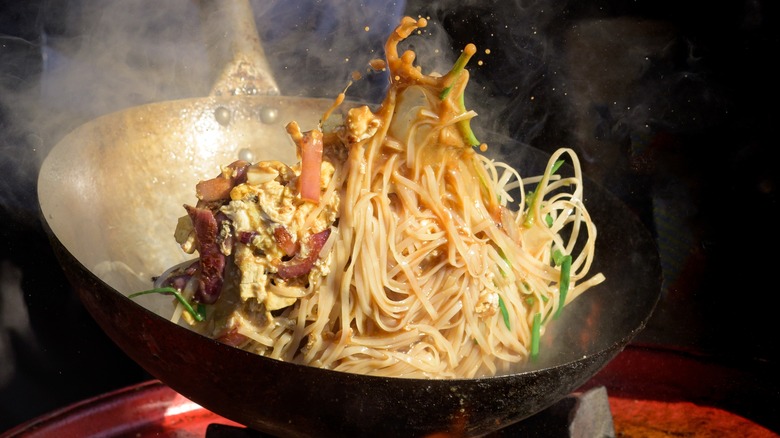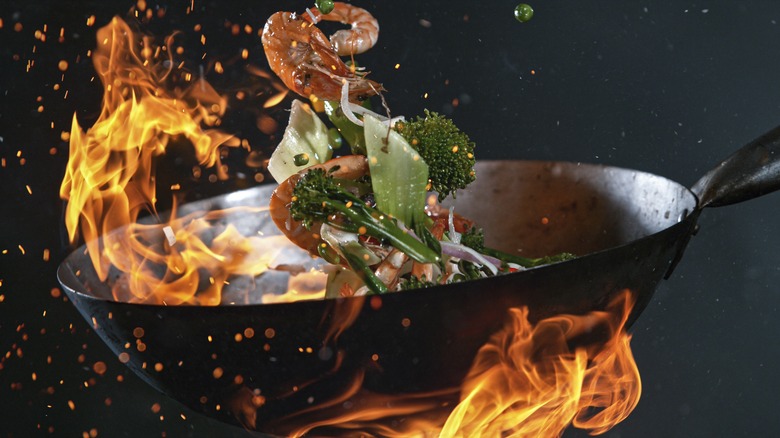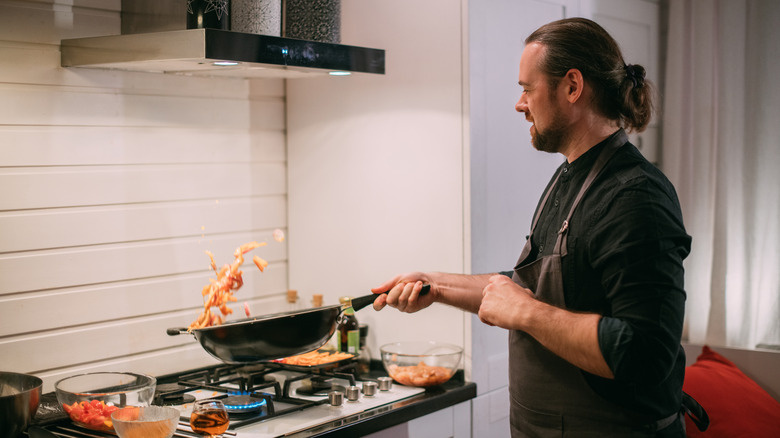Wok Hei: The Indefinable Quality Of A Perfect Wok Aroma
If you've ever tried to copy a recipe from your favorite Asian restaurant, you've likely been left disappointed. Even if you take the time to source all of the correct ingredients, gather the right cooking tools, and follow the recipe perfectly, you still might not be able to match your favorite takeout.
This is because of the secret ingredient of Asian cooking that you won't find in the store. The elusive wok hei, or "breath of a wok," is the result of skillful wok cooking. Everyone from your local Chinese takeout restaurant to P.F. Chang's, and especially high end locations make use of wok hei.
Michelin says that obtaining wok hei qualities in stir fried food gives it a quality of a smoky, caramelized, and umami flavor. This cooking method is the result of high heat cooking, and proper techniques that can take years to master. CNN reports that some researchers have even studied these cooking techniques to better understand their nature. The result was that in addition to the high heat cooking with a wok, it involves a precise flip.
Secrets of wok cooking
The wok is one of the world's oldest cooking vessels. School of Wok claims that the invention of the wok occurred about 2,000 years ago in the time of China's Han dynasty. The early models were made from heavy cast iron instead of the lighter carbon steel models available today. There are many theories as to why the wok was created including: to have a versatile, all-in-one cooking pan that could feed large crowds, and as a means to conserve cooking oil.
As The New York Times points out, woks have a bowl shape with steep rising sides. This allows the bottom of the pan to become scorching hot over a single concentrated flame, while the sides stay relatively cool. This may have helped conserve cooking oil by allowing multiple dishes to be prepared over a single flame, but it also helps create wok hei.
This bowl shape allows well-trained chefs to flip the frying foods into the air. Serious Eats claims that it is this process of circulating from intense heat into steam and evaporating oil molecules repetitively that truly creates wok hei. This flashy cooking technique causes a Maillard reaction in the food which creates complex flavors — all while keeping vegetables crunchy, and noodles chewy.
Best ways to get wok hei at home
Wok hei is an important quality of any good Chinese stir fry, but as Michelin points out, it can be hard to achieve the kind of high heat cooking on a home stove top. Professional kitchens have specific burners to use with woks that concentrate the many soft flames of a kitchen stove top into a single pillar of fire (via CNN). There are some methods to help you get the same results at home though.
Serious Eats says that one trick for the DIY fans at home is to modify your stove top. A stove top accessory called the WokMon can help give your round bottomed wok somewhere to rest, and let you cook over a proper flame. Just make sure everyone in your household is comfortable with large flames in the kitchen first.
Another, possibly more fire preventative method from Serious Eats, is to take your wok outside. Taking your wok, or another nonstick pan out to the grill, is a great way to get a similar high, direct heat under the surface of the wok. Those high temperatures and high flying foods might also be safer in a backyard than a kitchen as well. Serious Eats' last method is to use a blow torch. This direct flame allows your wok to reach the same high temperatures as commercial kitchens, and will add a nice, charred coating to your foods as well.


